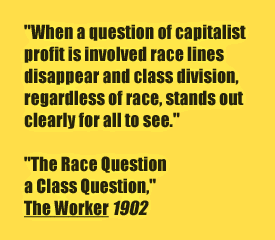|
|

Accommodation vs. Reform:
Washington, Du Bois,
Cooper, Wells-Barnett and Trotter
TOPICS >>>
Jim Crow Segregation
Tuskegee Machine
Lynchings of blacks throughout the South-- 1880s-1930s
Plessy v. Ferguson decision-- 1896
Niagara Movement-- 1905
National Association for the Advancement of Colored People--
1910
Colored Farmers Alliance and Cooperative Union-- 1886
Colored National Labor convention-- 1869
Knights of Labor, 1870s-1880s; United Mine Workers and black labor
Black fraternal organizations advocated racial "self-help"
Morrill Act of 1861, extended to black institutions in 1890
Theodore Roosevelt and the Republican Party
National Negro Business League
William Monroe Trotter, Boston Guardian
Boston Riot of 1903
Niagara Movement, 1905-1909: John Hope, pres. of Morehouse College
National Association for the Advancement of Colored People
Mary White Ovington, Joel Spingarn, Coatesville, PA Lynching, 1911
Amenia Conference, 19l6
White conservative philanthropy:
Peabody Fund, John F. Slater
Fund, Phelps-Stokes Fund
Private Black Colleges established in Reconstruction:
Fisk University, Atlanta University,
Lincoln University, Hampton Institute
Private/partial state supported included Tuskegee Institute-1881
separate but equal doctrine/Plessy v. Ferguson -1896
Black Clientage Politics of 1890s-1920s:
Cincinnati: Big Bill Copeland/Cox
Democratic Machine
Kansas City, Missouri: Pendergast Democratic Machine
Byrd Machine/Democrat Party of Virginia
Chicago: Big Bill Thompson, Republican mayor/Machine 1910s-20s
The era of Booker T. Washington and Accommodation: 1895-1915
Atlanta Compromise Address--
1895 / BTW 1856-1915
Washington's strategy:
Coalitions with white philanthropy,
conservative Democrats locally and
Republicans nationally, opposition to trade unionism, socialism,
Populism; supt. for industrial education, black business development;
"separate but equal" doctrine
PERSONALITIES >>>
Emmett J. Scott, chief lieutenant
of BTW
JC Dancy: federal recorder of Deeds, editor, AMEZion Quarterly Review
R.L. Smith, founder
of the Farmer's Improvement Society;
principal of Oakland, Texas Normal School; US Marshal for Eastern Texas
J.C. Napier, lawyer,
Nashville, TN city council;
Register of the Treasury
Robert Russa Moton, vice president of Hampton Institute,
President of Tuskegee Institute, 1916-1935.
James Weldon Johnson, diplomat, song writer, novelist,
"Lift Every Voice and Sing", The Autobiography of an Ex-Colored Man- 1912;
became National Secretary of the NAACP, 1920-1930
Victoria Earle Mathews, social workers, born 1861 in slavery;
journalist, edited BTW's book Black Belt Diamonds, president of Women's
Loyal Union Club; National Association of Colored Women:
founder in 1897 White Rose Industrial Mission in NYC; died in 1907
W.E.B. Du Bois, 1868-1963
Education: Fisk, Harvard; Wilberforce Univ., Atlanta University
Key ideas: double consciousness; the color line; women's rights
and universal suffrage; the theory of the talented tenth; advocacy
of worldwide solidarity among people of color/Pan-Africanism;
direct challenge to segregation laws via courts, education.
Souls of Black Folk(1903); The Philadelphia Negro(1899); John Brown (1909);
The Crisis NAACP editor, 1910-1934; Black Reconstruction (1935)
READINGS >>>
Marable and Mullings, eds., Let Nobody Turn Us Around Section Two, Number 8, pp. 167-172 and Numbers 11-16, pp. 181-230.
W.E.B. Du Bois, The Souls of Black Folk, entire text.
Giddings, When and Where I Enter, Chapters I, IV, V, VI and VII, pp. 17-31, 75-131.
MULTIMEDIA >>>
W.E.B. Du Bois, The
Souls of Black Folk multimedia presentation
If you do not know the password, and you are in the course, email Craig
(craig@columbia.edu).
Lynchings of blacks throughout the South, 1880s-1930s-photos
Films:
Documentaries on W.E.B. Du Bois, Booker T. Washington, Ida B. Wells-Barnett, Mary Church Terrell
|










